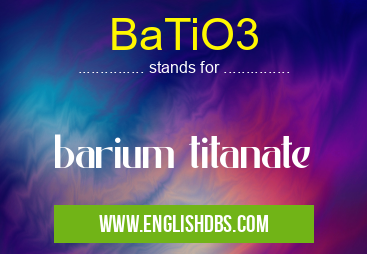What does BATIO3 mean in CHEMISTRY
BaTiO3 is an abbreviation that stands for barium titanate, a chemical compound used in ceramic capacitors. It is composed of barium (Ba), titanium (Ti) and oxygen (O). BaTiO3 has a variety of uses across many industries, from electronics to optics to medical devices. BaTiO3 is an important material in the semiconductor industry, as it can be used to create ceramic capacitors. Ceramic capacitors are essential components in many types of electronic circuits, due to their ability to store electrical energy and release it when needed.

BaTiO3 meaning in Chemistry in Academic & Science
BaTiO3 mostly used in an acronym Chemistry in Category Academic & Science that means barium titanate
Shorthand: BaTiO3,
Full Form: barium titanate
For more information of "barium titanate", see the section below.
Uses of BaTiO3
BaTiO3 is highly used in the semiconductor industry due to its unique properties. It has piezoelectric and dielectric properties, meaning it can produce an electric charge when subjected to mechanical stress or tension. Hence, these capabilities make it useful for creating electro-mechanical transducers such as microphones and loudspeakers. Additionally, it is able to store large amounts of electrical energy which makes it ideal for use in high-voltage condensers or other types of ceramic capacitors. Its dielectric properties also make BaTiO3 a popular choice for creating high-frequency filters and various types of antennas. Lastly, BaTiO3 can be used in optical applications due to its ability to transmit light with low loss at certain wavelengths.
Essential Questions and Answers on barium titanate in "SCIENCE»CHEMISTRY"
What is barium titanate?
Barium titanate is a dielectric ceramic material composed of barium and titanium. It is often used in electronic capacitors, known for its high dielectric constant and piezoelectric properties.
What type of material is barium titanate?
Barium titanate is an inorganic, non-metallic compound, typically classified as a ceramic oxide.
How is barium titanate most commonly used?
Barium Titanate has many uses but it is most commonly used as an electrostatic capacitor in consumer electronics, such as computers and televisions.
How does barium titanate work?
Barium Titanate works by charging up a static electric field which can then be discharged when needed to power an electrical device or release energy. Its ability to store energy like this makes it useful for many electronic applications.
Are there any adverse effects associated with using barium titanate?
No adverse health effects have been reported as a result of using bariunm titanate. However, it is always advised to handle the substance with proper safety precautions such as wearing protective clothing and eye protection when handling this material.
Is barium titanate combustible?
No, barium titanate itself isn't flammable or combustible due to its chemical makeup. However, materials which contain this substance may be combustible if exposed to extreme heat or fire. As a precautionary measure, all materials such as batteries and capacitors should be kept away from open flames and other sources of ignition.
Where does barium titanate come from?
Barium Titanate is typically manufactured through a process known as wet synthesis which involves mixing different chemical compounds together under controlled conditions to create the desired product. The raw ingredients for this process are sourced from suppliers around the world depending on availability and consumer demand for the material.
What are some common uses for barium titante?
Common industrial applications for barinum titanium include transducers, sensors, actuators, dielectrics in multi-layer integrated circuits (MLIC), microwave devices and varistors among others. In addition, it also has medical applications such as manufacturing prostheses for dental implants due to its biocompatibility with human tissue.
Final Words:
BaTiO3 is an important material in the semiconductor industry due to its special properties and versatile applications. Its combination of piezoelectricity and dielectricity enable it to be used as a component for electronic circuits such as ceramic capacitors or transducers like microphones and loudspeakers. Additionally, its optical features provide potential applications for creating low-loss light transmission at certain wavelengths. Because of its multifaceted uses across multiple industries, barium titanate remains a widely sought after material by researchers and engineers alike.
